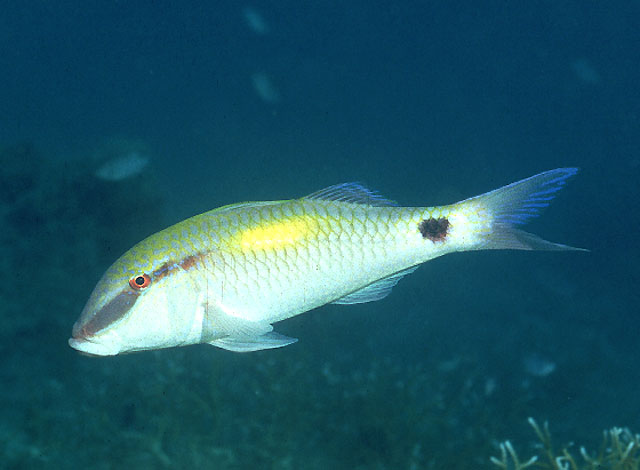
|
Parupeneus indicus (Shaw, 1803) Indian goatfish |
||
| Indian goatfish, Malapunti, Yangutan, Agingoy, Aluman, Amarilis, Balaka, Balaki, Bayabao, Bayahao, Bayhao, Bisugo, Bud-bod, Dalagang bukid, Dumpilas, Henos, Hinok, Intsek-intsek, Kapon, Malmot, Manites bato, Manitis, Remoliete, Saging saging, Salamulyete, Salmonete, Salmonito, Salmunete, Saramulyete, Saramulyeteng hato, Saramulyeteng hulik, Saramulyeteng tagisi, Ti-ao, Ti-aw, Tiao, Timbongan, Timbugan, Timbungan, Timhungan, Tuyo, Ubakan | ||

|
|
photo by
Cook, D.C. |
| Family: | Mullidae (Goatfishes) | |||
| Max. size: | 45 cm TL (male/unsexed) | |||
| Environment: | reef-associated; brackish; marine; depth range 10 - 30 m | |||
| Distribution: | Indo-Pacific: Yemen coast of the Gulf of Aden and southern Oman, along the east coast of Africa to Port Alfred, South Africa (33°S), east to the Caroline and Somoan islands; southern Japan to southern Queensland. | |||
| Diagnosis: | Dorsal spines (total): 8-8; Dorsal soft rays (total): 9-9; Anal spines: 1-1; Anal soft rays: 7-7. Diagnosis: Pectoral rays 16 (rarely 15 or 17). Gill rakers 5-7 + 18-21 (total 24-27)> Body depth 3.25-3.75 in SL; head length (HL) 2.9-3.25 in SL; snout length 1.65-1.95 in HL; barbel length 1.3-1.5 in HL. Longest dorsal spine 1.5-1.8 in HL; penultimate dorsal ray about equal to last dorsal ray in juveniles, 1.05-1.2 in length of last dorsal ray of adults; pectoral-fin length 1.35-1.55 in HL; pelvic-fin length 1.3-1.5 in HL. Body greenish brown to reddish brown dorsally, the scale edges narrowly dark, shading to whitish or pale pink ventrally, with a nearly round black spot as large or larger than eye on side of caudal peduncle, two-thirds of which lies above the lateral line; a large, horizontally elongate yellow spot (sometimes partly white) on lateral line below interdorsal space; barbels white; irregular pale blue lines extending anteroventrally and dorsoposteriorly from eye; second dorsal and anal fins with irregular oblique pale blue lines; caudal fin yellowish gray with faint blue lines paralleling rays; peritoneum dark brown (pale brown to white in other species of the genus except Parupeneus barberinus) (Ref. 54393). | |||
| Biology: | Inhabit shallow sandy or silty areas (seagrass substrata) of coastal and inner lagoon reefs (Ref. 9710, 54393). Occur singly or in schools (Ref. 5213). Large adults usually at moderate depths to about 30 m (Ref. 48636). Feed on benthic invertebrates; the diet including small crabs, amphipods, shrimps, small octopuses, polychaete worms, and small fishes (Ref. 54393). Marketed fresh (Ref. 5284). | |||
| IUCN Red List Status: | Least Concern (LC); Date assessed: 11 March 2015 Ref. (130435) | |||
| Threat to humans: | harmless | |||
| Country info: | Known from San Vicente, N. Luzon (Ref. 58652). Nasugbu, Batangas (Ref. 107854). Davao Gulf, Sarangani Bay, Bongo Island and Paril-Sangay Protected Seascape, Moro Gulf (Ref. 106380). Also Ref. 1602, 37816, 48613, 53416, 54393, 121724. | |||